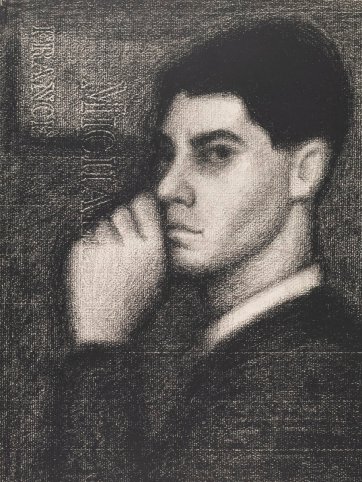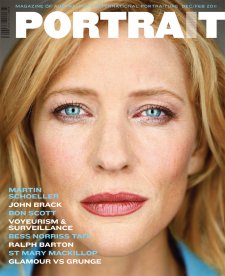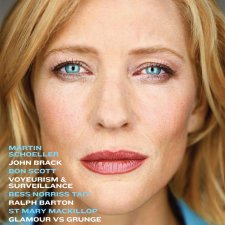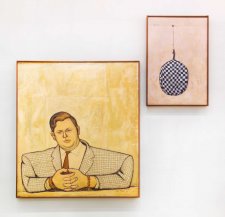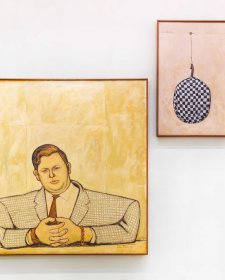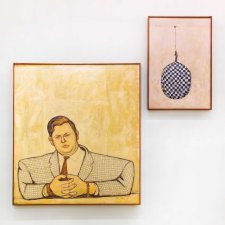John Brack grew up in Melbourne and studied at the National Gallery School at night while working as a junior insurance clerk. After serving in the AIF from 1940 to 1946 he resumed his studies, and in 1948 he married a fellow student, Helen Maudsley.
The following year he secured a job in the National Gallery of Victoria’s Print Room, where he worked as an assistant to Ursula Hoff until 1951, leaving to take up the position of art master at Melbourne Grammar School. His paintings excited attention immediately; his first exhibited work, Barber’s Shop 1952, was purchased for the National Gallery of Victoria soon after it was shown, as was Collins Street, 5pm 1955. In 1959 Brack was one of seven artists who contributed to the Antipodean Exhibition, proclaiming the importance of figurative art and Australian subject matter. In 1962 he became Head of the National Gallery Art School. Six years later, finally confident that he could make a living as a full-time artist, he resigned. His work was critically acclaimed, and sales followed exhibitions in regular cycles for the rest of his life. Over the last few years, first The Bar 1954 then The Old Time 1969 set new auction records for the sale of Australian paintings.
Brack painted shopfronts, school yards, gardens and housing estates, nudes, office workers, ballroom dancers, jockeys, trainers, brides, housewives, families, drinkers. Portraits comprise about ten per cent of his collected works, but there are few overt self representations amongst them. Michael Desmond, who curated Portraits by John Brack 2007 – the last major exhibition of the National Portrait Gallery in Old Parliament House – noted that Brack tended to include his own shadowy figure in works that a casual observer would not take for portraits at all, such as Menswear 1953 and The Bar 1954. Sometimes he would appear more directly, for example in Still life with Self Portrait 1963. His characteristic visual intellect is perhaps taken to the limit in Inside and Outside 1972, where the artist appears as a ghostly image on the window pane, mirrored on the shiny surfaces of the wares in the display. The one and many reflections in that work, Desmond suggests, ‘affirm “I am” and simultaneously ask “who am I?”’ It seems a reasonable description of countless outright self portraits; and indeed, like many artists, Brack did resort to such, both as a means of studying facial features using a readily-accessible model (whose patience is equal to the artist’s own), and as a form of selfanalysis or interrogation.
A gift from a young Brack to his friend, Ursula Hoff and on loan for many years to the National Gallery of Victoria, the National Portrait Gallery purchased this velvety drawing at auction from Hoff’s estate in Melbourne in April 2010. When this little pastel drawing was exhibited in Portraits by John Brack, Michael Desmond called it ‘the typical image of a young artist: alert, curious and concerned with identity while absorbing the lessons of a mentor, in this case French artist Georges Seurat, master of solid form and subtle tone.’ In an essay accompanying the major exhibition John Brack at the National Gallery of Victoria in 2009, Sasha Grishin explains that the twenty-eight year old Brack was studying Seurat at art school at the time he drew this work, and used L’Appel 1883–84, a study for Une Baignade, Asnières, as a guide to his own materials and composition. Seurat was testing ways to paint a boy making a sound through his hands to carry across the water. Eighty years later, Brack, Grishin suggests, presents himself as ‘the artist who makes a silent comment on his times’.
The curator and art historian Ursula Hoff ao obe, art historian, was educated in Hamburg, Munich and London before arriving in Melbourne in 1939 to take up a position as secretary to the Women’s College at the University of Melbourne, the head of which had, in effect, offered to help a Jewish refugee leave England. She was appointed Assistant Keeper of Prints and Drawings at the National Gallery of Victoria under the Chairmanship of Keith Murdoch in 1942. A Foundation Fellow of the Australian Academy of the Humanities in 1970, she worked at the Gallery until 1975, becoming Assistant Director in 1968; after ‘retiring’, she became London adviser to the Felton Bequest. Having taught for many years, she was senior associate in fine arts at the University of Melbourne from 1985.
Brack and Hoff were friends for many years; he first sketched her in the early 1950s, and although he had pretty much given portraiture away by the 1980s, in 1985 he agreed to paint her portrait on commission from Patrick McCaughey, at that time Director of the National Gallery of Victoria.
Just as its tones and textures are finely modulated, inherent in this self portrait by John Brack are shades and layers of associations and references. It is a potent addition to the Gallery’s increasingly rich collection of artists’ portraits of themselves.

